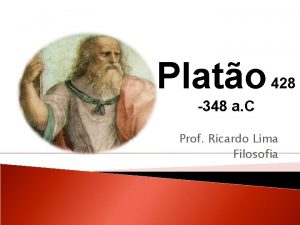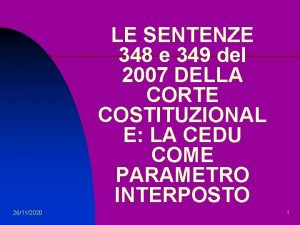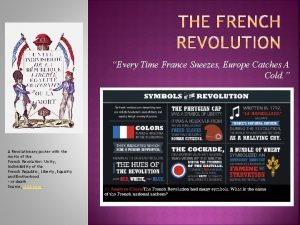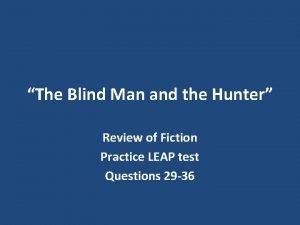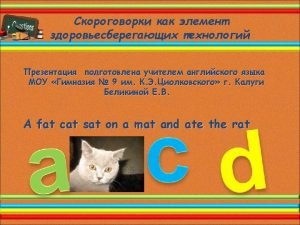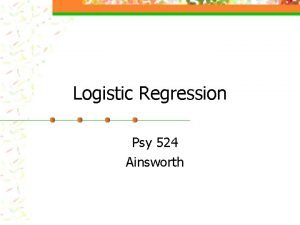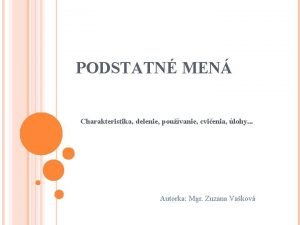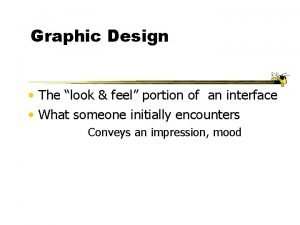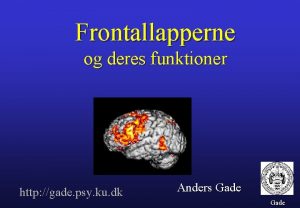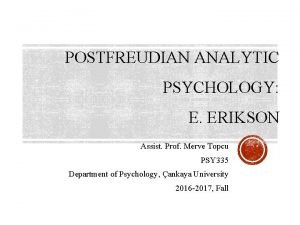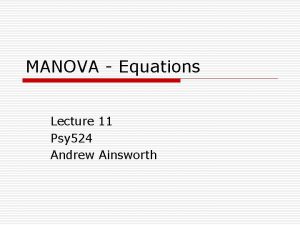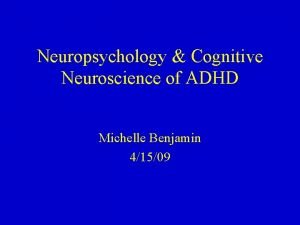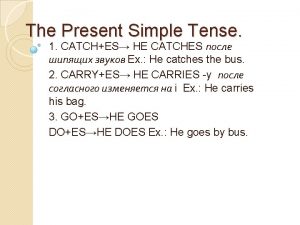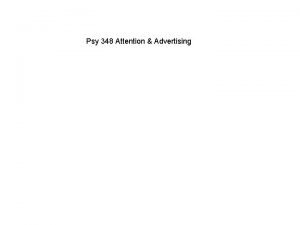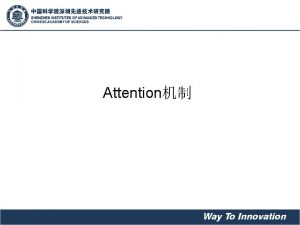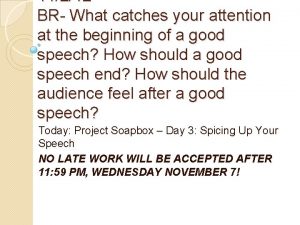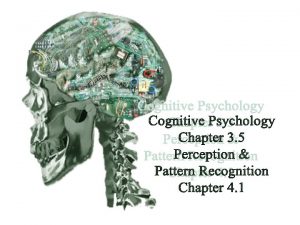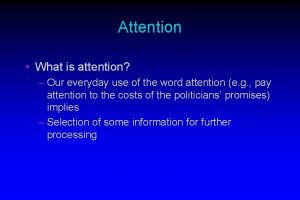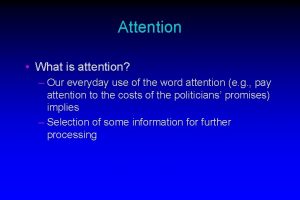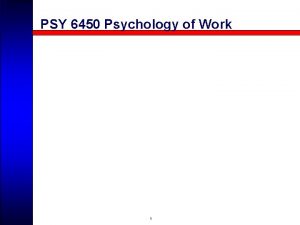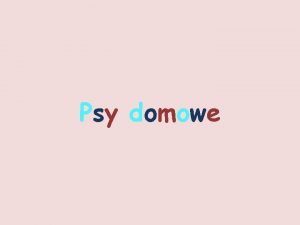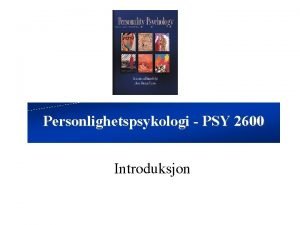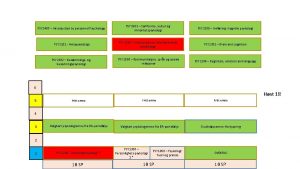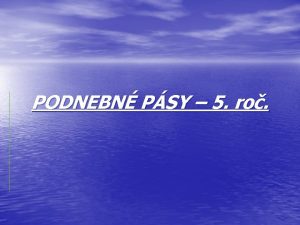Psy 348 Attention What catches our attention What









































- Slides: 41

Psy 348: Attention

What catches our attention? What holds our attention? How many things can we attend simultaneously? What happens when two or more things compete for our attention?





Saint Sebastian - Gerrit van Honthorst (circa 1623)





Selective attention Attending to one thing while tuning out other things Old telephone problem: conversations often overlapped during phone calls. Telephone company needed to understand what aspects of the undesired conversations were the most interfering to the main conversation

Colin Cherry – cocktail party phenomenon Easy for us to “tune out” unwanted info in real life; but digital solution is difficult Dichotic listening – via earphones: two diff messages – one to each ear Shadowing: listener attends to one ear & repeats the message aloud This ensures that she is actually attending to the intended message Results: Physical characteristics of the stimulus are paramount in successful attending; semantic characteristics are largely irrelevant E. g. , loudness, gender, language, is noticed. But not the actual content of the second message. One peculiar exception: personally relevant info IS noticed: listener’s name, . . . Note: NOT this Colin Cherry! We want the one from 1953. . .

The theoretical problem: we cannot attend to everything simultaneously so there is some sort of limiter: but what is it, and how does it work?

Two theoretic perspectives Filter & bottleneck theories – the barrage of incoming information is reduced to a manageable level by some sort of filter or attenuator Donald Broadbent – Early sensory-level filter Anne Triesman – Early sensory-level attenuator Deutsch & Deutsch – Late semantic/response filter Attentional-resource theories – finite pool of cognitive resources available for attending Donald Norman & Daniel Bobrow, Daniel Kahneman, Chris Wickens

A schematic of the issue Remember that modern cognitive psychology assumes that attention-perceptionthinking-etc are mechanical in nature & function. Almost all theorists use the computer as an analogy for how cognizing occurs: Input → Central Processor → Output

Stimuli (things in the world) stimulation of one or more of the senses “Sensory information” – there’s a REALLY LOT of it at any given moment The problem: where & how do we focus on some of that info & discard/ignore the rest? Sensory information senses short-term storage (this is very brief, a. k. a. , “sensory memory”) central processor (“conscious awareness, ” a. k. a. , STM) think about the info, conjecture, worry, rejoice, etc decision re: response long-term storage (a. k. a. , “long-term memory”) physical response

Theorists have really struggled with that “focusing” problem. Most often, they have thought of it as a “limiter” issue. “The Magical Number Seven, Plus or Minus Two: Some Limits on Our Capacity for Processing Information" is one of the most highly cited papers in psychology. “ It was published in 1956 by the cognitive psychologist George A. Miller: . . . the number of objects an average human can hold in working memory is 7 ± 2. - Wikipedia entry

Seven #’s – sounds familiar! The phone # problem. . .

Three leading theoretical perspectives

Donald Broadbent – Early sensory-level filter Considering Cherry’s findings from dichotic listening & shadowing: we must have some way to focus attention based on physical characteristics of the sensory information. So Broadbent proposed an early filter based on physical info at the sensory level – prior to actual consciousness

Sensory information senses FILTER short-term storage (this is very brief, a. k. a. , “sensory memory”) central processor (“conscious awareness, ” a. k. a. , STM) think about the info, conjecture, worry, rejoice, etc decision re: response long-term storage (a. k. a. , “long-term memory”) physical response

This idea works pretty well – it accounts for Cherry’s findings about physical info in the unattended message it also explains why the semantic content of the unattended message is not recalled However, there was that peculiar problem regarding “highly relevant” info in the unattended message, such as the listener’s name – that info is recalled. Broadbent’s filter model couldn’t explain how that could happen.

Anne Triesman – Early sensory-level attenuator A collection of filters that work together, based partly on physical characteristics, and partly on semantic characteristics Broadbent’s physical filter + other filters as well as a “dictionary” of personally important stuff Info that is highly relevant to one’s identity, interests, etc. is permanently stored in a dictionary, & incoming info is checked against that dictionary to see if it warrants immediate attention Irrelevant info is “attenuated” so that it doesn’t pass readily into conscious awareness

Sensory information senses FILTERS / ATTENUATORS / DICTIONARY Input short-term storage (this is very brief, a. k. a. , “sensory memory”) central processor (“conscious awareness, ” a. k. a. , STM) think about the info, conjecture, worry, rejoice, etc decision re: response long-term storage (a. k. a. , “long-term memory”) physical response This model works pretty well in accounting for how we focus attention, and a considerable amount of research is consistent with it. However, it is rather cumbersome: all those filters, dictionaries, etc.

Deutsch & Deutsch – Late filter All sensory info gets into the central processor, and the processor then quickly focuses on a small amount of that info to which it will respond, based on one’s needs, interests, etc. The other info is ignored & hence very quickly forgotten. Input senses short-term storage (this is very brief, a. k. a. , “sensory memory”) central processor (“conscious awareness, ” a. k. a. , STM) RESPONSE SELECTION think about the selected info, conjecture, worry, rejoice, etc decision re: response long-term storage (a. k. a. , “long-term memory”) physical response This model makes sense, in that we don’t have to have multiple filters, etc. However, research failed to provide good evidence for it.

Kahneman - Attentional Resources After a while, theorists & researchers began to think that the filters/attenuators approach might be a dead-end: it explains some of attentional selection, but not all of it. These theories explain attentional limitations as a limit on processing capacity instead of as a physical filtering process. Ordinary computer’s processor Human’s processor The Columbia Supercomputer at NASA's Advanced Supercomputing Facility at Ames Research Center.

Kahneman argues that we have a finite processing capacity that is controlled by "enduring dispositions, " "momentary intentions, " and "arousal. " Resource limitation theories also predict that, as a skill becomes more automated, its processing is faster & more efficient, and thus takes up less of one's attentional capacity. These theories are very promising: they can account for attention based on both physical & semantic aspects of information. However, they do not successfully account for our ability to divide our attention and concentrate on two or more tasks at the same time.

Summary: Attention is selective: Physical qualities (brightness, loudness, tone, timber, texture, etc) Semantic qualities (one’s interests, concerns, hopes, fears, etc) Filter & attenuator models propose a selection mechanism based on structures. Resource allocation models propose a section mechanism based on processes. Neither approach has gained complete acceptance in cognitive theory: i. e. , we still don’t fully understand how attentional selection occurs.

The paradigmatic task: The Stroop task

Emotional Stroop task Happy – Sad – Angry – Neutral Impose emotional words over faces depicting either congruent or incongruent emotional states – the Stroop effect occurs, just as it does with colors Many variations: Use colored letters, but the background word is an emotional word Use words that are related to a particular neurosis, and compare color-naming by “normal” people versus people with the particular neurosis Etc.

Divided attention #1 factor in auto accidents: ____________ Recent #2 factor in auto accidents: _________ Ulric Neisser ~ Robert Becklen ~ Elizabeth Spelke We can learn to attend to two tasks simultaneously, but it takes considerable practice Success in divided attention depends on difficulty of the tasks Two very hard tasks = almost impossible to divide attention One very hard task, one easy = can be learned with difficulty Two easy tasks = easy to learn

Controlled versus automatic processes Note that controlled processes require full conscious awareness These usually involve difficult tasks Automatic processes often occur with little or no conscious awareness These usually involve easy tasks Or else difficult tasks that have been very well learned Automatic process X divided attention Once an attentional task has become automatic, e. g. well-learned, then divided attention with another, relatively easy task, is possible

Application: Attention & Advertising Two compelling attentional issues in advertising: To catch attention (problem in selective attention) To hold attention (problem in sustained attention) The underlying principles in advertising involve several cognitive processes or attentional stimuli, crossed with various motivators that advertisers believe are fundamental to (1) humans in general or (2) the target group in particular: Cognitive factors or stimuli Subconscious or preconscious Classical conditioning Repetition Contrast Brightness Color Movement Information Etc. Motivators Sex Health ~ relief from illness Companionship Happiness/”good times” Curiosity Etc. Note “emotionality” component of many of the motivators

Common psychological techniques used in ads: Classical conditioning desirable something/somebody/event – repeatedly paired with – product/message Repetition — a component of classical conditioning, but also works by itself — often presented as variations on a theme Strong attention attractors: sharp contrasts bright colors movement humans, animals famous person surprise etc “Intrinsic motivators” sex humor fear hunger etc Intellectual stimulation puzzles irony & wit complexity whimsy social & cultural concerns subtlety – e. g. , in contrasts, colors, composition, emotional tone etc

Classical conditioning is one of the major ways that humans learn things. Review: Pavlov’s classical conditioning paradigm: UCS UCR The UCS automatically elicits the UCR CS is paired with the UCS several times. Then CS CR That is, the CS now elicits the CR, even though the UCS is no longer present.

Advertisers use classical conditioning to induce consumers to like/want particular products UCS Something desirable/attractive/etc [Attractive people, places, things. . . ] UCR To want, desire, want to be like, etc [We admire, like, want, . . . ] CS Product/message CR We want, desire, etc So we learn to want, like & presumably purchase a particular product This could also be used to lead people to support causes, political parties, etc

High-contrast bright colors, white background catches attention Young child peculiar “adult” expression – distant, reserved hands in pocket echo distant/reserved image overly wide eyes catches & holds attention High contrast: baby GAP – white on black background GAP – large letters baby – small letters catches attention Simplicity helps to focus attention Classical conditioning framework: UCS = attractive, sophisticated child UCR = like the look of the child CS = GAP clothing CR = like GAP clothing

Does “subliminal” / embedded information actually work in advertising?

Marcel (1980’s) Priming & categorization: Priming stimuli: visual stimuli presented very fast (20 – 110 msec) [Aside: saccadic eye movements ~ 200 msec] Participant generally cannot name what she saw Subsequent categorizations tend to be based on the priming stimuli Zajonc 1970’s – 1990’s Emotion is a major factor in cognitive processes – much research etc Unfortunately ignored by academic psychology [C. f. , Descartes’ influence] WH & Jesse Howard positive, negative, or neutral words presented very briefly (~50 msec) Afterwards the emotional connotations influenced participants in a liking task, although they couldn’t say whether they’d seen the words before. So, regarding advertising: Subliminal messages do not work directly – that is, the viewers will not subsequently recall the specific product being advertised. However, combining “subliminal” with emotion & classical conditioning, repetition, and various stimulus properties, such as movement, color, contrast, etc. , and the ad’s effect may be almost irresistible.

Summary Advertising is intensively concerned with attracting and maintaining attention. This involves extraordinary management of several attentional factors. “Sensory” factors are carefully designed to maximize “attention-getting” effects – color, contrast, movement, etc. Cognitive factors are manipulated intensively depending on the product and the target audience The general approaches tend to fall into 2 or 3 major categories: Sex Information Humor/Delight Repetition used intensively to “fix” the audience’s awareness of the product Ads are almost invariably based on classical conditioning or sheer repetition Both of these are intimately related to both selective and sustained attention
 428 - 348
428 - 348 Round 348 to the nearest hundred
Round 348 to the nearest hundred Sentenze gemelle 348 e 349 del 2007
Sentenze gemelle 348 e 349 del 2007 428-348
428-348 Round 348 to the nearest ten
Round 348 to the nearest ten Isabey paris
Isabey paris Quotation hook example
Quotation hook example Who marked when france sneezes europe catches a cold
Who marked when france sneezes europe catches a cold The blind man and the hunter
The blind man and the hunter Three grey geese in a green field grazing
Three grey geese in a green field grazing What are knock down fittings used for
What are knock down fittings used for When sam listens to his girlfriend susan in the restaurant
When sam listens to his girlfriend susan in the restaurant Psy
Psy Veľký bradáč charakteristika
Veľký bradáč charakteristika Regression psy
Regression psy Psy
Psy Ucf psych advising
Ucf psych advising Alla kulikova
Alla kulikova Psy sanin
Psy sanin Ngdali
Ngdali Psy
Psy Psy
Psy Psy 2055
Psy 2055 Psy ku
Psy ku Psy
Psy Psy 335 purdue
Psy 335 purdue 11 psy
11 psy Psy 226
Psy 226 Xxxxblue
Xxxxblue Psy 2055
Psy 2055 Psy walsh
Psy walsh Psy
Psy Euro psy
Euro psy Alternating attention vs divided attention
Alternating attention vs divided attention It has come to our attention
It has come to our attention Awareness of ourselves and our environment is
Awareness of ourselves and our environment is Our awareness of ourselves and our environment.
Our awareness of ourselves and our environment. Ok 313
Ok 313 Our life is what our thoughts make it
Our life is what our thoughts make it Our awareness of ourselves and our environment is called
Our awareness of ourselves and our environment is called Our life is what our thoughts make it
Our life is what our thoughts make it We quail money makes us quail why?
We quail money makes us quail why?
